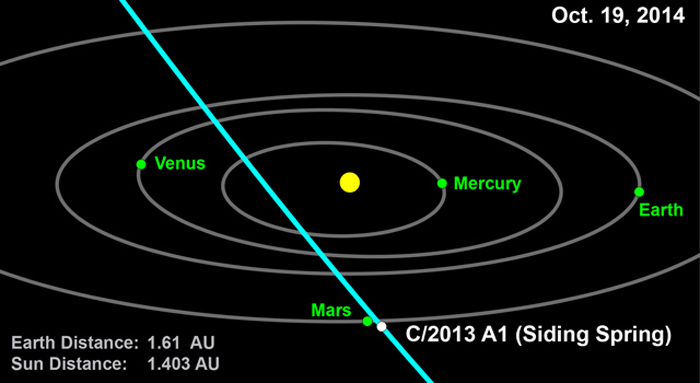.

This computer graphic depicts the orbit of comet 2013 A1 (Siding Spring) through the inner solar system. Image credit: NASA/JPL-Caltech
.
Comet 2013 A1 (Siding Spring) will make a very close approach to Mars in October 2014.
The latest trajectory of comet 2013 A1 (Siding Spring) generated by the Near-Earth Object Program Office at NASA's Jet Propulsion Laboratory in Pasadena, Calif., indicates the comet will pass within 186,000 miles (300,000 kilometers) of Mars and there is a strong possibility that it might pass much closer. The NEO Program Office's current estimate based on observations through March 1, 2013, has it passing about 31,000 miles (50,000 kilometers) from the Red Planet's surface. That distance is about two-and-a-half times that of the orbit of outermost moon, Deimos.
Scientists generated the trajectory for comet Siding Spring based on the data obtained by observations since October 2012. Further refinement to its orbit is expected as more observational data is obtained. At present, Mars lies within the range of possible paths for the comet and the possibility of an impact cannot be excluded. However, since the impact probability is currently less than one in 600, future observations are expected to provide data that will completely rule out a Mars impact.
During the close Mars approach the comet will likely achieve a total visual magnitude of zero or brighter, as seen from Mars-based assets. From Earth, the comet is not expected to reach naked eye brightness, but it may become bright enough (about magnitude 8) that it could be viewed from the southern hemisphere in mid-September 2014, using binoculars, or small telescopes.
Scientists at the Near-Earth Object Program Office estimate that comet Siding Spring has been on a more than a million-year journey, arriving from our solar system's distant Oort cloud. The comet could be complete with the volatile gases that short period comets often lack due to their frequent returns to the sun's neighborhood.
Rob McNaught discovered comet 2013 A1 Siding Spring on Jan. 3, 2013, at Siding Spring Observatory in Australia. A study of germane archival observations has unearthed more images of the comet, extending the observation interval back to Oct. 4, 2012.
NASA detects, tracks and characterizes asteroids and comets passing close to Earth using both ground- and space-based telescopes. The Near-Earth Object Observations Program, commonly called "Spaceguard," discovers these objects, characterizes a subset of them, and plots their orbits to determine if any could be potentially hazardous to our planet.
JPL manages the Near-Earth Object Program Office for NASA's Science Mission Directorate in Washington. JPL is a division of the California Institute of Technology in Pasadena.
Quelle: NASA
-

Mars may have a really bad day next year on October 19th. That’s when there is a very slight chance a newly discovered comet may impact our neighboring planet, says NASA.
Comet C/2013 A1 (Siding Spring) was discovered by Australian Robert H. McNaught, a prolific comet and asteroid hunter just two months ago and NASA’s Near-Earth Object Program Office at the Jet Propulsion Laboratory , in Pasadena, Calif., has been constantly refining the comet’s exact trajectory ever since.
Latest orbital calculations have the icy visitor passing by Mars at only 31,000 miles (50,000 kilometers) – only two-and-a-half times the distance that the outer moon Deimos orbits.
Astronomers watching the icy interloper predict that as more observations are accumulated over time, it’s more and more likely Mars is going to dodge the bullet and only get a close shave . The possibility of impact however has not been completely ruled out yet, says NASA, giving the comet a 1 in 600 chance of walloping the Red Planet.
If Siding Spring would hit, the force of impact may truly be monumental. Based on observations to date the comet nucleus could be a real monster – as big as 9 miles (15 km) to 31 miles (50 km) wide. With it’s velocity clocked at 35 miles (56 km) per second, the energy force of the collision could be measured in the billions of megatons, resulting in a crater hundreds of miles wide. This could be an impact that rivals the one that wiped out the dinosaurs 65 million years ago on our planet and would be bright enough to be even seen with the naked eye from Earth.
Chances are however that it will just barely miss the planet, but comet Siding Spring may still become visible through binoculars and backyard scopes for us Earthlings in the Southern Hemisphere around mid-September 2014. It should also produce quite a sky show as seen from the surface of Mars.
Current brightness magnitudes estimate that the comet will be very bright to even the digital eyes of the two working Mars rovers – Opportunity and Curiosity. Can hardly wait to see the amazing photos from these intrepid robotic explorers!
So it will definitely be worth watching what the comet does in the coming weeks and months- whether it impacts Mars or not.
Quelle: NationalGeographic
5323 Views

